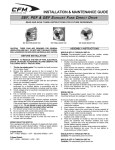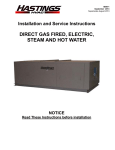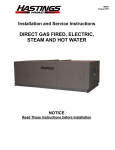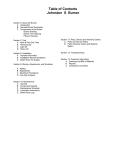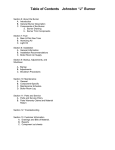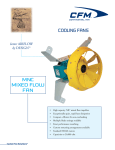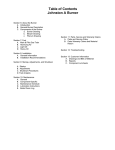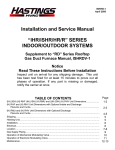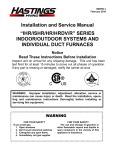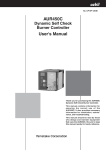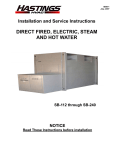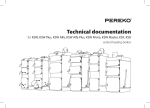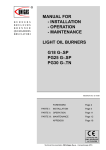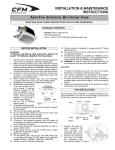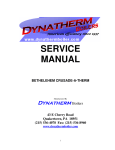Download Afx Manual - Hastings HVAC
Transcript
ISAFX – 1 October 2002 Installation and Service Manual AEROFLO AFX SERIES HEATERS GAS, OIL GAS/OIL FIRING Notice Read These Instructions Before Installation TABLE OF CONTENTS Page Section I. – General Information ……………………………………………………………………………………………. 2 A. Purpose …………………………………………………………………………………………………………….. B. Shipping ……………………………………………………………………………………………………………. C. Optional Factory Service ………………………………………………………………………………………... D. Equipment Description …………………………………………………………………………………………… 2 2 2 2 Section II. – Installation Procedure …………………………………………………………………………………………. 4 A. Handling the Equipment …………………………………………………………………………………………. B. Locating the Unit ………………………………………………………………………………………………….. C. Location of Accessories ………………………………………………………………………………………….. D. Electrical Connections ……………………………………………………………………………………………. E. Piping Connections ………………………………………………………………………………………………… F. Exhaust Duct Connection ………………………………………………………………………………………… G. Optional Remote Control Panel Installation …………………………………………………………………… 4 6 6 6 6 12 12 Section III. – Pre-Start Inspection ……………………………………………………………………………………………. 15 A. Procedure …………………………………………………………………………………………………………… 15 Section IV. – Start-Up ……………………………………………………………………………………………………. …. 15 A. Procedure ………………………………………………………………………………………………………….. 15 Section V. – Maintenance Schedule and Lubrication Requirements ……………………………………………..…. 22 A. Maintenance Schedule …………………………………………………………………………………………… B. Lubrication Instructions ………………………………………………………………………………………… 22 23 Section VI. – Troubleshooting ………………………………………………………………………………………………. 24 A. Troubleshooting Gas-Fired Units ……………………………………………………………………………….. B. Troubleshooting Oil-Fired Units …………………………………………………………………………………. C. Webster Electric Two-Stage Fuel Pump for Oil-Fired Units ……………………………………………... D. Sundstrand Fuel Pump for Oil-Fired Units …………………………………………………………………….. E. General Troubleshooting Tips ……………………………………………………………………………………. -I- 24 24 24 26 28 SECTION I. – GENERAL INFORMATION A. PURPOSE The purpose of this manual is to present a guide for proper installation, maintenance, and operation of Aeroflo AFX Series heaters, and to supplement, but not to replace, the services of qualified field service personnel to supervise the initial start-up and adjustment of the Aeroflo unit. Persons without previous experience with large commercial and industrial equipment should not attempt the initial adjustment and checkout procedure which is essential before such installations may be considered as ready for operation. This manual should be made readily available to operating personnel as an aid in trouble-shooting and proper maintenance. B. SHIPPING All Aeroflo units are shipped in three sections: fan section, heating section, and discharge section. These sections have been designed to facilitate field installation. All options and accessories are shipped mounted and wired whenever possible within the limitations of shipping and handling. Any wired accessories which have been disassembled for separate shipment require no additional conduit or wire for field reassembly. All wire leads will be tagged for ease of reconnection in the field. Shipments are made F.O.B. Hastings, Nebraska, by rail or truck. In either case, the unit is securely strapped, tied, and blocked to prevent shipping damage. All shipments are checked by an inspector before they are accepted by the carrier. Parts that are shipped unmounted are noted on the bill of material. These parts, where feasible, are packaged and shipped with the units. Upon receipt of shipment, all units should be checked against the bill of lading to insure all items have been received. The units should be checked carefully for physical damage in the presence of the carrier’s representative. If parts are missing or damage has occurred, a claim should be filed immediately with the carrier. All Aeroflo units are given a complete operations test and control circuit checkout before shipment. A copy of the flame test report, wiring diagram, and bill of material is included with each unit shipped. If correspondence with the factory is necessary, please provide the unit model and serial number. C. OPTIONAL FACTORY SERVICE Periodic service on any piece of mechanical equipment is necessary for efficient operation. Hastings HVAC, Inc. has a nationwide service organization available to make quick and dependable servicing of make-up air, return air, heating, ventilating, or air handling types of equipment. Hastings HVAC, Inc. also provides factory start-up service which includes the presence of a service engineer to perform the initial start-up and adjustment of the equipment, instruction of the owner’s maintenance personnel in proper operation and maintenance, and return calls for any adjustments required to a particular unit within a period of sixty (60) days after start-up is complete. Customer’s loss of power or fuel will not constitute need for any return calls. Consult the factory for quotations on periodic or start-up service. D. EQUIPMENT DESCRIPTION The Aeroflo heater is a rugged floor-mounted industrial grade space heater that achieves uniform building temperature, moisture control, and maximum heating efficiency using the principle of low velocity constant air circulation to heat large air volumes to lower temperatures. Refer to Bulletin AFX-1 for additional details. -2- 1. Cabinet and Frame Rugged tubular frame and all cabinet surfaces are painted with heat and corrosion resistant industrial enamel. Unit includes four side return air screens. An expanded metal, low velocity discharge plenum with either two, three, or four sides screened is standard. 2. Fans There are two heavy-duty, 10 gauge, turbine-bladed propeller fans each with a one-piece solid shaft and self-aligning pre-lubricated ball bearings. Fixed drives are standard on all units. An open dripproof ball bearing squirrel cage induction T-frame motor is provided as standard for all voltages. 3. Burners Standard burner is Hi-Lo-Off Gas (G) – Power type with pilot spark ignition and main burner pilot ignition for use with natural, manufactured, mixed, liquefied petroleum gas or liquefied gas/air mixture. Included in the manifold are main gas electric shut-off valve with linkage to combustion air damper, main and pilot gas pressure regulators for maximum inlet pressure of 2 PSIG, pilot gas-air mixer and pilot solenoid valve. Minimum standard entering gas pressure is 4 ounces. Light Oil (LO) – High pressure oil atomizing type with mechanically forced draft suitable for burning fuels through #2 grade to maximum of 40 SUS at 100ºF. The unit incorporates an oil pump, combustion air fan and drive, combustion air damper operator, oil solenoid valve, oil filter and pressure gauge. An oil pressure regulator is supplied with a pressure system. Heavy Oil (HO) – Low pressure air atomizing type suitable for burning fuel oils through #4 grade to a maximum of 125 SUS at 100ºF. The unit incorporates an oil metering pump, motor, oil nozzle, ignition transformer, oil filter, oil valves, pressure gauge and oil pressure regulator (when required). A circulating pump or a gravity feed system must be supplied by customer for use with this burner. Gas/Light Oil (GLO) – Combination fuel, power burner equipped with components as included with gas burner and light oil burner described above. Automatic fuel changeover accomplished by means of an electric toggle switch in the burner control cabinet. Gas/Heavy Oil (GHO) – Combination fuel, power burner equipped with components as included with gas burner and heavy oil burner described above. Automatic fuel changeover accomplished by means of an electric toggle switch in control cabinet. 4. Fuel and Electric Controls Standard components for Aeroflo AFX Series heaters include a Nema 1 control box with electronic flame safeguard system with ignition transformer, motor starter, control transformer, high temperature limit switch, air flow switch, and an oil or gas electrical control system. 5. Control System The standard control system for Hi-Lo-Off burner operation is obtained with a two-stage thermostat that closes in sequence on a temperature drop below setpoint. Fan operation is continuous. A detailed sequence of operation for standard gas-fired heaters is provided later in this manual. The thermostat is factory furnished and wired in the inlet plenum. -3- The optional On-Off control system is obtained with a single pole, single throw thermostat that closes upon a temperature drop below setpoint. Fan operation is continuous. Thermostat is factory furnished and wired in the inlet plenum. The optional modulating control system has an On-Off thermostat as described above plus a modulating thermostat to control a modulating butterfly fuel valve. Fan operation is continuous. Thermostats are factory furnished and wired in the inlet plenum. 6. Remote Control Panel (Optional) The optional panel is furnished with a heavy duty toggle switch and three 115 volt signal lights as depicted in Figure 8. The switch controls the blower and the burner. The signal lights indicate supply blower operation (white light marked “blower”), burner operation (amber light marked “heating”), and safety lockout (red light marked “lockout”). Remote control panel lids are 16 gauge brushed stainless steel. Wiring box dimensions are 8” x 5” x 3 ½” deep. All wiring is 16 AWG 16/30 standard 105 thermoplastic or equivalent, color coded per corresponding wiring diagram. SECTION II. – INSTALLATION PROCEDURE This equipment shall be installed and wired in accordance with regulations of the National Board of Fire Underwriters, National Electric Code, and local governing bodies. The following recommendations are not intended to supplant any requirements of federal, state, or local codes having jurisdiction. Authorities having jurisdiction should be consulted before installations are made. Local codes may require additional safety controls and/or interlocks. A. HANDLING THE EQUIPMENT The Aeroflo unit has been designed for rigging and handling through the use of special lifting lug hooks installed on the top of each section. As explained previously, the unit is designed for shipping in three sections. The fan section, burner section, and discharge plenum section must be reassembled in the field. When unloading and setting the heater, use the lifting lugs provided or move the sections on rollers. Hooks, jacks, or chains must not be used around the casing, exhaust fan, or main control panel. For convenience in shipping, the discharge plenum section sits on top of the fan section. Please note that the lifting lugs on the rear of the fan section are manufactured so that the burner section will fit on the fan section only one way. Figure 1 depicts a typical unit assembly. To be properly set, the Aeroflo unit should be placed on a solid foundation and set exactly as detailed later. During transit, unloading, and setting of the unit, bolts and nuts may have become loosened, particularly in the pillow block ball bearing assemblies on the fan section. It is recommended that all nuts and set screws be tightened. Turn fan shafts by hand to make certain that propeller fan does not rub against fan venturi, and that bearing lock rings are tight. Open the cover on the electrical control box located near the middle on the side of the burner section. Box can be opened by turning main disconnect switch to the “off” position. Inspect all wire terminals and wiring terminations to ensure that all connections are tight. -4- -5- B. LOCATING THE UNIT Prior to locating the unit, authorities having jurisdiction should be consulted before installations are made. Approval permits should be checked against the unit received. Locate the Aeroflo unit exactly level. Special attention should be given to the exhaust duct connections, electrical power and control hook-up points, and fuel connection points. This information should be crosschecked with the position of support beams and stand pipes to insure that clearance dimensions coincide with those of the unit. C. LOCATION OF ACCESSORIES Where applicable, standard or optional accessories will be placed inside the fan section of the unit for shipment, and must be removed and installed by the mechanical or electrical contractor. D. ELECTRICAL CONNECTIONS All wiring must comply with all applicable local, state, provincial, and national electric codes. Since shipment of unit requires disassembly after factory flame test, reconnection of main fan motor leads will be required in the field. Connect electrical wires (supplied in factory furnished conduit) to secondary side of main fan motor starters. All motor leads are tagged to facilitate rewiring in the field. See wiring diagram provided with equipment. Complete all wiring to any optional accessories as shown on unit bill of material and electrical wiring diagram as required before applying voltage to the unit. The total amperage of the main disconnect switch, blower motor, and control circuit transformer fusing is affected by the addition of 25% to the full load amps as required by the National Electric Code. Check the supply voltage before energizing the unit. The maximum voltage variations should not exceed +/10%. Phase voltage unbalance must not exceed 2%. E. PIPING CONNECTIONS All gas and/or oil piping connections are not shown in this manual because of the many manifold arrangements available due to approval code requirements and different types of modulation. All piping must comply with “Standards of National Board of Fire Underwriters” and all applicable local codes. Contact factory if exact piping dimensions are required. Protective pipe caps are furnished on manifolds for shipment from factory; these caps should be removed for installation. Run correctly sized piping to unit. Install manual gas or oil hand shut-off valve, gas pressure and/or oil pressure regulator, and oil strainer if not already installed. Please note that gas or oil line pressure must be as shown on specification plate when unit is operating at full input. 1. Fuel Piping – Gas Models Figure 2 presents a table of gas piping sizes for varying flow rates. A typical Hi-Lo-Off gas piping manifold is shown in Figure 3. Gas burner connection will vary between 1” and 3” depending on the Aeroflo model and type of gas. On gas systems, vent pressure regulator(s) and vent valve (if included with unit) to outside of building. With vent pipe outside, install a proper vent cap and/or screen to prevent entrance of foreign material and plugging. 2. Fuel Piping – Oil Models Figure 4 depicts a typical oil piping manifold, while Figures 5 and 6 present typical oil tank locations. Tanks should be readily accessible for filling from tank cars or trucks, yet located near the heaters, if practical, to minimize piping problems. National Fire Protection Association (NFPA) insurance, and local codes and standards should all be checked carefully prior to installation. -6- Length of Pipe (Equiv. Ft.) 15 30 45 60 75 90 105 120 150 180 210 240 270 300 450 600 GAS FLOW CAPACITY (CFH) ½ 76 52 43 38 ¾ 172 120 99 86 77 70 65 1 345 241 199 173 155 141 131 120 109 100 92 Iron Pipe Size (IPS) Inches 1¼ 1½ 2 3 750 1220 2480 6500 535 850 1780 4700 435 700 1470 3900 380 610 1290 3450 345 545 1120 3000 310 490 1000 2700 285 450 920 2450 270 420 860 2300 242 380 780 2090 225 350 720 1950 205 320 660 1780 190 300 620 1680 178 285 580 1580 170 270 545 1490 140 226 450 1230 119 192 390 1030 4 13880 9700 7900 6800 6000 5500 5100 4800 4350 4000 3700 3490 3250 3000 2500 2130 6 38700 27370 23350 19330 17310 15800 14620 13680 12240 11160 10330 9600 9000 8500 7000 6000 4 8464 5986 4885 4232 3785 3454 2992 2677 1891 1544 1338 6 22472 15894 12972 11238 10050 9170 7945 7108 5022 4101 3554 8 79000 55850 45600 39500 35300 32250 29850 27920 25000 22800 21100 19740 18610 17660 14420 12480 A. Pressure; ½ # or Less Length of Pipe (Equiv. Ft.) 50 100 150 200 250 300 400 500 1000 1500 2000 GAS FLOW CAPACITY (CFH) 1 244 173 141 122 109 99 86 77 54 44 38 Iron Pipe Size (IPS) Inches 1¼ 1½ 2 3 537 832 1680 5018 380 588 1188 3549 310 480 970 2896 268 416 840 2509 240 372 751 2244 219 339 685 2047 189 294 594 1774 169 263 531 1587 119 185 375 1121 97 151 306 915 84 131 265 793 B. Pressure; ½ # to 1# Figure 2 – Gas Flow Capacity for Piping of Different Sizes and Lengths -7- 8 41516 29364 23965 20760 18567 16943 14679 13132 9279 7577 6567 -8- -9- -10- -11- A buried tank is preferred from the aspect of heater maintenance. Tanks installed above ground subject the oil to variations in temperature and viscosity which may necessitate frequent burner adjustment. Underground tanks should be set on a firm foundation and, where necessary, securely anchored to prevent floating. Attention should also be given to providing adequate corrosion protection for underground tanks. All tanks must have minimum 1 ¼” diameter vent pipe extending not more than 1” into tanks and located at opposite end from fill line. Vents must have weatherproof hoods and sufficient height to prevent obstruction by snow or ice. Vents for tanks installed above ground must have flame arrestors. All piping should be wrought iron, steel or copper with standard fittings not less than ½” iron pipe size. All fittings must be absolutely airtight. All screwed fittings should be coated with acid-resisting pipe cement. Use swing joints for pipe connections to buried tanks. Size of oil line connection is 1/4” on LO and GLO models and 3/8” on HO and GHO models. Suction and return lines must be minimum ½” I.D. Fill lines should be 2” in diameter located at opposite end of tank from other piping. The suction line should terminate 6” from the bottom of the tank. If bottom of tank is above the level of the fuel pump, a hand shut-off valve should be installed at the tank. In all cases, install a hand shut-off valve on the intake side of the factory furnished strainer. This strainer must be installed ahead of the heater fuel pump. Do not install a hand shut-off valve in the return line. Model LO heaters are equipped with a either a Sundstrand or Webster pump, factory set at 100# pressure. The pump is designed for a maximum lift of 15’ with maximum horizontal run of 100’, equivalent to 15” to 17” of vacuum. Model HO heaters are equipped with a metering pump only. A separate pump, supplied by the purchaser, is necessary to supply oil to the metering pump at 3# pressure. F. EXHAUST DUCT CONNECTION Installation of exhaust stack must comply with regulations of the National Board of Fire Underwriters and local governing bodies. The exhaust stack, exhaust stack connector, exhaust stack support and miscellaneous items related to the exhaust stack are to be supplied and installed by others. Connect the exhaust stack to the heater breeching box and run stack through roof as shown in Figure 7. Avoid use of long horizontal exhaust pjpe runs; the exhauster fan has ample capacity for venting the heater, but cannot perform satisfactorily against strong back drafts or excessive stack resistance. G. OPTIONAL REMOTE CONTROL PANEL INSTALLATION 1. Refer to Figure 8 for guidelines. 2. All writing must comply with applicable electric codes. 3. Align box with spirit level. 4. If box is to be surface mounted, three (3) mounting holes in back of box are recommended, one in each top corner and one at bottom center. If mounting holes are to be located in side of box as shown, four (4) holes are recommended, two at top and two at bottom. 5. If wiring box is to be recessed, install so that open edge of box will be flush with finish wall. Install optional flush mounting wall plate. Examine wiring box and control panel for clearance before providing conduit hole(s). 6. Control panel is furnished with components wired to coded terminal strip. Installer to connect numbered terminal blocks on remote control panel to corresponding terminal block(s) in master control panel on unit. 7. Use proper wire sizing practices when running wires for the remote control panel. -12- -13- -14- SECTION III. – PRE-START INSPECTION A pre-start inspection is extremely important and should be completed with greatest attention given to detail. This will insure against possible unit damage on start-up and will save valuable analysis time in the event malfunctions occur on start-up and check-out. A. PROCEDURE 1. Check to see that all factory installed pipe plugs have been removed. 2. Check supply voltage against unit voltage. 3. Check all electrical connections in the main control panel. 4. Check that all fuses are installed and that fuse sizing agrees with the unit bill of material. 5. Check to see if all gas, oil, or gas/oil connections are tight and that all joints have been properly lubricated. 6. Check positioning of flame rod (or photocell), spark electrodes, nozzles, cone, and swirler. Make sure the combustion air fan is fastened securely to motor shaft. 7. Check for cracks in refractory around the blast tube. This inspection requires close observation with the aid of a good flashlight. Even a tiny crack can cause a positive pressure within the combustion chamber and result in faulty burner operation. 8. Check fan supply area to insure freedom of shaft rotation and proper belt tension. Check to see that fans are tight on shaft and turn freely without rubbing the fan venturi. The motor and shaft should turn readily by hand pull of the belts. Properly adjusted belts can be easily depressed about one inch. Make sure the fan shaft pillow block bearings are tight. 9. Check fan motor to insure that pulleys are secure and drive belts are tight. 10. Check all areas for cleanliness. SECTION IV. – START-UP All safety and operating controls have been checked during the factory test period; however, it is advisable to complete a similar check when first operating the unit. Before attempting any service work, make sure all electrical switches and manual valves are closed. A. PROCEDURE 1. Remove any shipping blocks from: a. Gas pressure switch(s) (if required) may have shipping screws. Remove screws if supplied. b. Unit programming controller may be shipped with a paper shipping block. Remove programmer cover and remove paper shipping block – reinstall cover and adjust manual reset. c. The high limit should be set for 200ºF. The fan control should be set at 120ºF on high and 90ºF on low. Note that fan operation is continuous and that control circuit on high side is not required for proper system operation. -15- d. Combustion air, exhaust air, and rear main fan air proving switches are factory set for 0.2” to 0.4” W.C. 2. Open pilot gas cock and purge air from gas line through plugged tee in pilot line. Caution: Use a lighted torch to ignite the gas as air is purged from the pilot gas line. Do not depend on sensing the odor of gas to determine if the gas line is purged. 3. On oil systems, remove pipe plug from gauge port of oil pump (see Figure 13 and 14) for purging air from oil system. Use a bucket to catch oil from this opening during the purging process. A length of copper tubing will eliminate oil mess. Open manual oil valve in the oil suction line. 4. Push rest button on unit programming controller. 5. Close main disconnect switch. 6. The On-Off burner switch on the master control panel will operate the fans. 7. All three phase motors were properly phased during factory testing. If rotation is reversed, interrupt main power supply and interchange any two of the incoming power leads. Reestablish power and recheck fan operation. 8. On three phase units, the starter contacts should pull in and hold quietly without “clatter.” If they do not operate quietly, check immediately for proper line voltage. Even temporary low voltage at start-up will cause constant operating trouble and must be corrected before the Aeroflo heater is placed in service. 9. Recheck all set screws on motor sheave and fan blade. Check alignment of belts and pulleys. Run fans for a few minutes and adjust motor take-up if necessary. Motors are mounted on an adjustable base shown on Figure 9. Do not over-tighten belts since excessive tension will reduce belt life and cause excessive load on bearings. After initial start, allow the belts a few days’ running time to become seated in pulley grooves, then readjust as necessary. Do not roll belts over grooves or sheaves as this will result in permanent belt damage. 10. Open Manual hand valves. After manual valves have been opened, burner should ignite automatically if thermostat is in control circuit. 11. The burner assembly for either gas or oil-fired Aeroflo heaters generally requires readjustment of the flame test settings for proper operation under actual field conditions. The most accurate guides to proper burner adjustment are: a. Flame travel within the combustion chamber. b. Temperature and CO2 content of the flue gasses. c. Proper action of the flame sensor. WARNING: Never stand within the swing radius of the access door when making flame observations through the peephole. Proper flame travel within the stainless steel combustion chamber differs from the pattern usually desired for a refractory lined furnace. Never adjust the burner to produce a short “bushy” flame concentrated in the front end of chamber as shown in Figure 10A. Such a flame concentrates heat release in the front end of chamber and creates a short circuit between the burner and economizer tube section which results in high stack temperature. Figure 10B illustrates a flame that is much too long and will cause over-heating of the rear wall. A correct flame should be fairly vigorous, free of smokey haze, and should barely impinge on the rear wall of the chamber. Figure 10C illustrates proper flame travel. This long steady flame provides adequate time for complete combustion and balanced heat release to all surfaces of the chamber. Typical draft conditions are noted in Figure 11 for firing at full rate capacity. Adjust to field conditions when necessary. -16- 12. BURNER START-UP a. Gas Systems: Open the air louver on the air inlet to approximately the one-half open position. Open the manual gas valve slowly, burner will ignite. Open valve until gas pressure on the gauge is approximately 4 ounces. Observe flame conditions. If gas flame has yellow or yellow tip appearance, open combustion air louver wider until flame appears short and hard. Adjust gas pressure regulator to hold 4 ounces gas pressure on burner while firing with the manual gas cock in the wide open position. Read gas meter serving burner, input should be approximately that stated on the burner name plate. If not, readjust regulator to obtain rated input. NOTE: Check to see if other appliances are on before reading meter. When the gas input rate is established, air adjustments may be made. The final air setting should produce a flue gas analysis of between 8 ½% and 9 ½% CO2. Your local gas utility may aid you in making burner adjustments if you do not have the proper instruments. Start and stop burner several times to insure proper operation. Check for proper functioning of high limit and operating control. Burner is now ready for normal operation. b. Oil Systems: Oil pump will run if flexible coupling is connected between fan hub and pump shaft. Oil (and air) will come out of purging port; when oil runs in a clear stream, shut off control switch. Oil pressure gauge may now be screwed into gauge port. Open combustion louver on air inlet to approximately one-half open position (use gas setting if unit is combination gas/oil if first operated on gas). Turn on burner control switch. Oil will ignite when oil solenoid valve opens; observe flame conditions. (Normally, gas/air setting will be correct for oil.) If too little air, oil flame is dark in appearance and smokey. With too much air, oil flame is bright and ragged in appearance, and tends to be hard to ignite. Before making final air adjustments, loosen lock screw by oil line connection on side of fan housing and move nozzle assembly while observing flame conditions until best flame appearance is obtained. The final air louver setting for oil should be made by closing the air louver until the flame first begins to produce smoke, then opening the air louver until the smoke disappears. This should result in 11% to 12 ½% CO2 as measured by a Bacharach Fyrite CO2 Analyzer, and less than No. 4 smoke as measured by a Bacharach #RCC-B True Spot Smoke Detector. NOTE: While a lower CO2 does not produce as high combustion efficiency as might be obtainable, it is better practice in making initial burner adjustments to set a lower CO2 (10% to 11%) to allow for the gradual reduction in fan air delivery due to dust and lint accumulating on the blower wheel. After a few weeks of operation, combustion efficiency will gradually raise to maximum efficiency that can be maintained over a period of time with average maintenance. Start and stop burner several times to insure proper operation; check for proper functioning of limit controls and operating controls. Burner is now ready for normal operation. 13. Referring to Figure 12, the typical sequence of operation for two-stage gas fired units is as follows: a. Closing fused disconnect switch (FD) will energize 115 volt control circuit through control transformer (T2). b. The On-Off burner switch (XB) on the master control panel will operate the fans. Unit burner operation is controlled by two-stage thermostat (TT). Blower motors (M1A and M1B) will operate through blower motor starters (1MA and 1MB) if starter overloads are all operational. The bonnet fan switch will remain in the electrical circuit after burner shutdown until blower has cooled heat exchanger to a temperature below the setpoint of the control. c. After continuous flame has been established, ignition transformer and pilot valve drop out of circuit. d. If safety shutdown should occur upon failure to ignite pilot, failure to light the main burner flame, or loss of flame while main burner is firing, the internal lockout switch will trip and lockout the protectorelay. -17- -18- -19- -20- -21- SECTION V.- MAINTENANCE SCHEDULE AND LUBRICATION REQUIREMENTS A. MAINTENANCE SCHEDULE Weekly 1. 2. 3. 4. 5. 6. Check that fan belts are tight and sheaves are lined up. Turn cleaning handle of fuel oil filter. Inspect oil pump and burner for oil leakage. Remove burner drawer assembly, inspect nozzle and electrode tips, and remove any carbon deposits. Check fuel oil supply. Check gas pressure at burner. Monthly 1. 2. 3. 4. Check all valves, piping and connections for leaks. Check combustion air louver settings as outlined in burner start-up procedures. Drain fuel filter. Make sure that photocell or UV sight glass is clean. Use lens tissue or soft tissue for cleaning the sight glass. 5. Remove pilot assembly and check spark electrode, flame rod, and pilot head. 6. Repeat control system check-out. 7. If coke oven gas or another type of dirty gas is being used, clean all valve seats, gas orifices, etc. Quarterly 1. Check limit control to insure operation. 2. Check stack condition and stack connection, supports and draft. 3. Lubricate exhaust pillow block ball bearing units with a good grade of ball bearing grease. Yearly 1. Remove rear access plate and clean out economizer tubes. (Place receptacle to collect soot as the swirlers are pulled out. Do not operate fans while access plate is off as considerable soot may be blown into surrounding area.) Be sure gasket is properly seated when replacing the access plate. 2. Inspect refractory around burner. If cracked or damaged, repair or replace. 3. Clean exhauster fan wheels. 4. Disassemble nozzle tip and clean. Clean all parts before reassembling. 5. Lubricate burner motor. 6. Lubricate fan motor as directed by motor manufacturer and inspect fan motor wiring for loose connections. 7. Check all control settings as outlined. 8. Clean gas pressure regulator. 9. Clean magnetic oil supply valve. 10. Turn main disconnect switch to “off” and open control box. Make sure controls are free from dust and grease. Check and clean relay and starter contacts, and inspect for loose wiring. Do not use file, sandpaper, or other abrasives to clean contacts – clean with notebook or heavy wrapping paper, not newspaper. NOTE: Keep screened air intakes clear of obstructions at all times. -22- B. LUBRICATION INSTRUCTIONS Item All 3 phase fan motors (1 HP to 100 HP) ODP or TEFC Manufacturer Bearing Type U.S. or equal Recommendation Single row ball bearings Note #2 Fractional HP exhauster motors, single phase, ODP or TEFC Century, G.E., or equal Bronze sleave bearings Note #3 Fractional HP burner motors and oil pump motors, single phase, ODP or TEFC Century, G.E., or equal Bronze sleave bearings Note #3 Self-aligning single row ball bearings, resilient mounted Note #1 Fan shaft bearings Fafnir or equal NOTES: 1. Sealed at factory – no lubrication required. 2. Remove top and bottom grease plugs. Install lubrication fitting in place of top plug. Annually flush with lithium base grease, consistency #2, until clean grease is discharged from bottom hole. Run motor with drain plug removed until grease stops flowing from drain. Reinstall drain plug. 3. Annually add ½ to 1 teaspoon of grade SAE 30 motor oil to each bearing. Add oil slowly so that felt packing will absorb the oil properly. -23- SECTION VI – TROUBLESHOOTING A. TROUBLESHOOTING GAS-FIRED UNITS 1. If blower fails to operate, check to see if: a. b. c. d. e. f. g. Main disconnect switch or circuit breaker is closed. All main fuses (if disconnect switch is used) are in line. Control transformer is supplying 115 volts to control circuit. Burner switch in master control panel is “on.” High limit control is in circuit (manual reset switch). Magnetic motor starter is in circuit (manual reset starter). There are any loose wires or connections in blower circuit at either terminal block or control components. h. Bonnet fan switch is in electrical circuit (burner must be operative). Also check the following optional controls, if used, to see if: a. Main gas cock is open – units equipped with manual reset low gas pressure switch must have gas at switch for proper switch operation. b. Low gas pressure switch in circuit (manual reset switch). c. High gas pressure switch in circuit (manual reset switch). 2. If exhauster or combustion air fans fail to operate, check to see if: a. b. c. d. e. Burner switch in master control panel is “on.” Room thermostat is operational and ambient space temperature is not above thermostat set point. High limit switch is in electrical circuit. Programming relay is functioning properly. Exhauster/burner starters, or relays if required, are operational and the fuses that protect them functional. 3. If pilot fails to light, check to see if: a. Proper exhaust air/combustion air is being sensed by exhauster/burner air flow switches. b. Ignition system is operational. c. Programming relay is functioning properly. 4. If main flame is not established, check to see if: a. Pilot has been established. b. Flame detector is sensing pilot. c. Programming relay is functioning properly. B. TROUBLESHOOTING OIL-FIRED UNITS. An adequate fuel supply must be available at the unit for proper operation. Check the specification plate or bill of material for proper fuel supply pressure. Unit control box voltage must be within +/ - , 10 volts of that which is specified on the specification plate for proper operation. Repeat steps 1 through 4 as previously outlined in troubleshooting gas-fired models. C. WEBSTER ELECTRIC TWO-STAGE FUEL PUMP FOR OIL-FIRED UNITS This unit, manufactured by Webster, is depicted in Figure 13 and may be used on either single-pipe or two-pipe systems. It is shipped from the factory set for single-pipe operation. When two-pipe installation is required, pipe plug included in envelope should be inserted in unit as shown in Figure 13 and tightened securely with 3/16” Allen wrench. -24- -25- 1. Procedure for single-pipe installation (preferred where bottom of tank is above fuel unit): a. Remove pipe plug from regular or optional inlet, as preferred. Connect inlet line using ¼” PT fittings. b. Tighten pipe plugs in unused inlet and two return line ports. c. Start burner and bleed all air from system by removing gage port plug. Allow oil to flow until it is clear, then replace plug and tighten securely. 2. Procedure for two-pipe installation: a. Remove ¼” pipe plug from optional inlet. Insert bypass plug furnished and tighten securely with 3/16” Allen wrench. b. If inlet connection is to be made to the same port, connect inlet line with ¼” PT fittings. Otherwise, replace ¼” pipe plug and connect inlet line to opposite port. c. Remove pipe plug from regular or optional return port, as preferred, and connect return line , using ¼” PT fittings. Tighten ¼” pipe plug securely in unused port. D. SUNDSTRAND FUEL PUMP FOR OIL-FIRED UNITS This pump, manufactured by the Sundstrand Machine Tool Company, is used to transfer oil from the supply tank to the heater (if tank is located within 100’) and to deliver oil to the burner nozzle at 100# pressure. Field service, other than pressure adjustment and strainer cleaning, is not recommended. The pump can be readily detached from the mounting base and motor coupling for replacement on an exchange basis. Contact Hastings HVAC, Inc Service Department for details. The pump is normally factory-set for a two-pipe system as described if Figure 14B; see Figure 14A for singlepipe system details. CAUTION: Where a single-pipe system is used, the bottom of the tank must be above the pump. 1. Procedure for two-pipe installation: a. b. c. d. e. f. Remove ¼” intake port pipe plug from either side of the unit and assemble intake line fittings. Unscrew return port plug. Remove internal bypass plug from cloth bag and insert as shown in Figure 14B. Assemble return line fittings in return port. Tighten ¼” pipe plug in unused intake port. On two-pipe system, air bleeding is automatic. 2. Procedure for single-pipe installation: a. Remove ¼” intake port pipe plug from either side of the unit and assemble intake line fittings. b. Tighten return port plug and ¼” pipe plug in unused intake port. c. When starting burner, be sure to bleed air out of the system by removing gage port plug allowing oil to flow until it is free of bubbles or foam. 3. Strainer a. Clean the strainer at least once each heating season. Remove the eight screws, cover, and cover gasket and lift out strainer. Clean with fuel oil or very hot water under pressure from the faucet. b. When replacing strainer, make sure that the strainer gasket is properly positioned. If there is evidence of rust inside the pump, be sure to remove water from the supply tank. -26- -27- E. GENERAL TROUBLESHOOTING TIPS 1. If blower operates and burner fails to operate, check to see if: a. b. c. d. e. f. g. h. Programming relay is in safety lockout. Ignition transformer is functioning properly. Spark gap is approximately 3/8”. Flame rod wire and spark ignition wire have loose connections and/or reversed wires. Any electrode insulators are cracked; replace as required. Pilot gas valve is open and that pilot has been lit (purge pilot gas line to eliminate any air). A three to four microamp reading of pilot is being attained. Main gas valve(s) is open. If burner ignites, but modulating valve fails to open, check to see if: a. Motor and controller and/or thermostat are wired properly. b. Discharge temperature controller or modulating room thermostat (if butterfly system is being used) is in electrical control circuit. 2. Any optional electrical items that are ordered can be the cause of nuisance shutdowns; check these items for proper operation if failure occurs. Check the supplemental control sheet with each unit for optional component service. At this point, all common causes of trouble have been covered and one or more of the remedies suggested should have corrected the malfunction. However, if the unit still does not function properly, notify the nearest Hastings HVAC, Inc. Field Service Engineer. -28- HASTINGS HVAC, INC__________________ 3606 Yost Avenue · Hastings, Nebraska 68901-1966 E-mail: [email protected] Homepage: www. hastingshvac.com
































